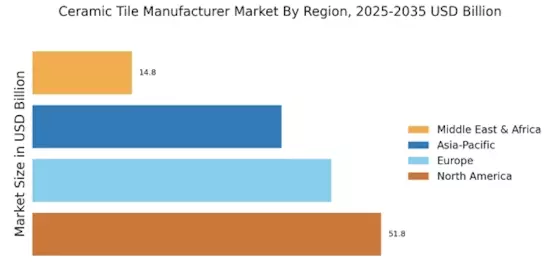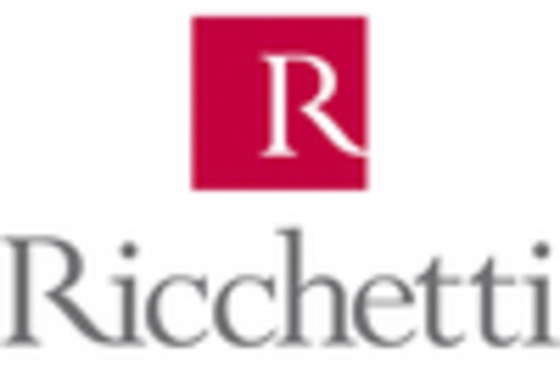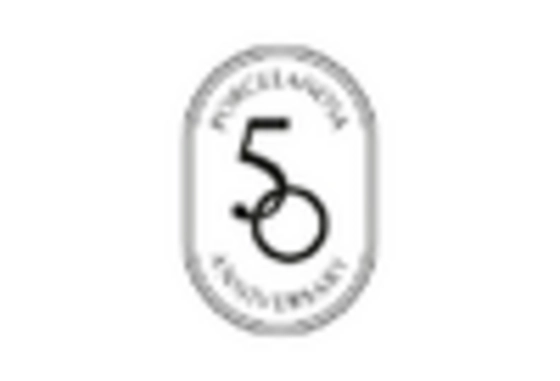Growth in Construction Activities
The Ceramic Tile Manufacturer Market is significantly influenced by the expansion of construction activities across various sectors. As urbanization continues to rise, there is an increasing need for residential, commercial, and infrastructural development. This growth in construction is accompanied by a heightened demand for ceramic tiles, which are favored for their durability and versatility. According to recent statistics, the construction sector is expected to grow at a rate of 5% annually, thereby driving the demand for ceramic tiles. Manufacturers are likely to benefit from this trend as they align their production capabilities to meet the needs of the booming construction industry. The synergy between construction growth and ceramic tile demand presents a promising opportunity for manufacturers to expand their market presence.
Increasing Focus on Sustainability
Sustainability has emerged as a pivotal driver in the Ceramic Tile Manufacturer Market. With growing environmental awareness, consumers are increasingly seeking eco-friendly products. Manufacturers are responding by developing tiles made from recycled materials and implementing sustainable production practices. This shift towards sustainability is not merely a trend; it reflects a broader societal movement towards responsible consumption. Market data indicates that the demand for sustainable ceramic tiles is expected to rise by 7% annually, as consumers prioritize environmentally friendly options. This focus on sustainability not only enhances brand reputation but also opens new market segments for manufacturers willing to invest in green technologies and practices. As the industry evolves, sustainability will likely remain a key factor influencing consumer choices and manufacturer strategies.
Rising Demand for Aesthetic Appeal
The Ceramic Tile Manufacturer Market experiences a notable increase in demand for aesthetically pleasing products. Consumers are increasingly prioritizing design and visual appeal in their home and commercial spaces. This trend is driven by the growing influence of interior design trends, which emphasize unique textures, colors, and patterns. As a result, manufacturers are compelled to innovate and offer a diverse range of ceramic tiles that cater to various tastes and preferences. Market data indicates that the demand for decorative tiles has surged, with a projected growth rate of approximately 6% annually. This shift towards aesthetic appeal not only enhances the market's competitiveness but also encourages manufacturers to invest in advanced production techniques to meet consumer expectations.
Technological Innovations in Production
Technological advancements play a crucial role in shaping the Ceramic Tile Manufacturer Market. Innovations in production processes, such as digital printing and automated manufacturing, enhance efficiency and product quality. These technologies enable manufacturers to produce intricate designs and patterns that were previously unattainable. Furthermore, the integration of smart technologies in tile production allows for improved energy efficiency and reduced waste. Market analysis suggests that companies adopting these innovations are likely to gain a competitive edge, as they can offer superior products while minimizing production costs. The ongoing evolution of technology in the ceramic tile sector not only meets consumer demands for high-quality products but also aligns with sustainability goals, thereby fostering growth in the industry.
Expansion of Retail and E-commerce Channels
The Ceramic Tile Manufacturer Market is witnessing a transformation in distribution channels, particularly with the rise of e-commerce. The expansion of online retail platforms has made ceramic tiles more accessible to consumers, allowing for a broader reach and increased sales opportunities. This shift is particularly beneficial for manufacturers, as it reduces the reliance on traditional brick-and-mortar stores. Market Research Future indicates that online sales of ceramic tiles are projected to grow by 8% annually, reflecting changing consumer shopping behaviors. Manufacturers are adapting their marketing strategies to leverage these digital platforms, enhancing customer engagement and streamlining the purchasing process. The growth of e-commerce not only facilitates market expansion but also encourages manufacturers to innovate in product presentation and customer service, ultimately driving sales in the ceramic tile sector.


















Leave a Comment